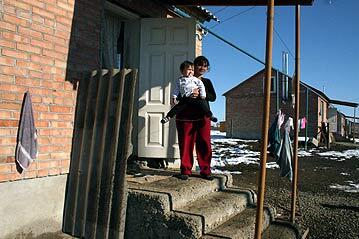Lesson plans for ages 15-18 in History: Population Displacement in the Commonwealth of Independent States
Lesson plans for ages 15-18 in History: Population Displacement in the Commonwealth of Independent States
-

Former refugee Khatuna Margieva outside her house in Tsalyk, one of three settlements in North Ossetia-Alania where UNHCR has built brick houses for refugees.
LESSONS 5 and 6: Case study - Tajikistan
In this lesson, students will study in more detail one of the CIS countries, Tajikistan, where a civil war broke out in 1992, only months after the country gained independence. Thousands of Tajiks fled from the countryside to the capital city of Dushanbe, to Afghanistan and elsewhere. The students will be introduced to UNHCR's role in the protection and reintegration of returnees and displaced people in Tajikistan.
Preparation
For the teacher, background information about the conflict in Tajikistan is provided in the Teachers' Resource Sheet 2: Restoring stability in Tajikistan.
Have ready the video Tajikistan: Mission Accomplished. This video lasts 15 minutes and is available free of charge from the Public Information Section, UNHCR, PO Box 2500, 1211 Geneva 2, SWITZERLAND.
The Minorities Map from the previous lesson will also be needed.
Procedure
Have the students locate Tajikistan on their map on the Activity Sheet from Lesson 1. Which countries share borders with Tajikistan?
Referring to the Minorities Map from the previous lesson, what is the ethnic composition of the population of Tajikistan?
Before showing the video Tajikistan: Mission Accomplished, provide a little background information about the inhabitants of Khatlon province. For details, see Teachers' Resource Sheet 2: Restoring stability in Tajikistan. Between the 1930s and 1970s, those inhabitants, the Garmis, were forcibly moved by the Communist regime from their own valley to Khatlon, to provide labour on the cotton farms.
Post-video discussion
- Not all the houses in Khatlon were destroyed in the civil war. The houses which were destroyed belonged to whom?
- a) Who is a returnee?
- b) What hardships in Khatlon did the first returnees face?
- How did UNHCR help in the protection of the returnees?
- a) Who were the two groups of people who lived in the village of Socialism?
- b) What happened in this village during the civil war?
- c) What specific problems faced the Garmis who returned to the village?
- d) How did UNHCR and the local authorities help in resolving the conflict between the Garmis and the Uzbeks?
- 'A man's home is his castle'. However, when the Garmis returned to their village, they found that their homes had either been destroyed or had been taken over by those who remained in the village. The government had rewarded its supporters with the property of those who had fled. How was the issue of house occupancy resolved?
- Whenever and wherever possible, UNHCR seeks to repatriate refugees. What factors must exist before refugees can return to their homes?


